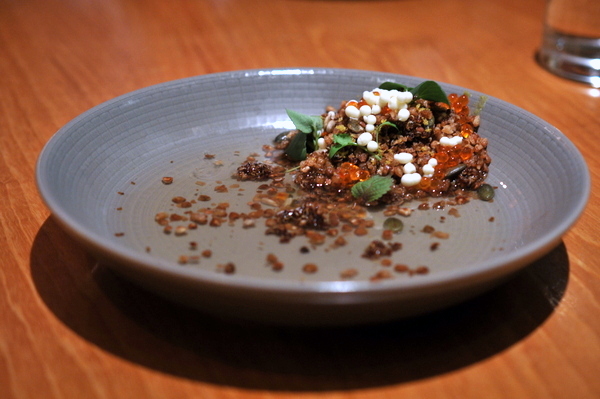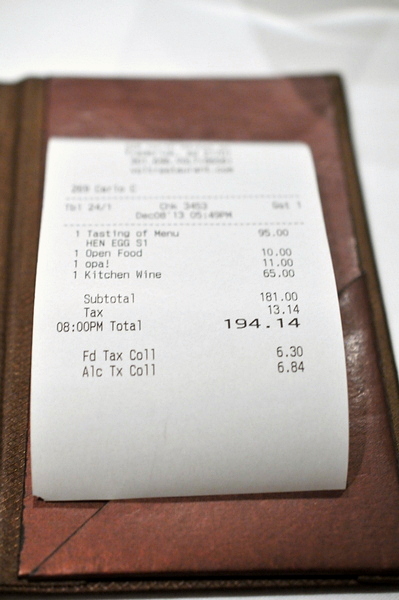1503 17th Street Northwest
Washington, DC 20036
(202) 462-8999
When it comes to sushi, Washington DC doesn't have the embarrassment of riches that Los Angeles has been blessed with, though the city does have a handful of good spots with Sushi Taro standing head and shoulders above the rest. To be clear, I'm speaking specifically about the restaurant's Omakase Counter where Chef/Owner Nobu Yamazaki and Chef de Cuisine Masa Kitayama create an intimate personal dining experience for up to six guests.
Coedo Shiro
Rather than dive right into the restaurant's sake list I thought I'd get warmed up with a beer. Like most Hefeweizens, the Shiro has a prevailing aroma of wheat with flavors of banana and clove.
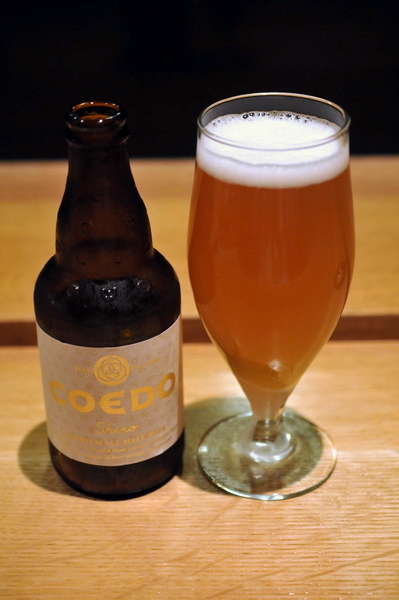 Goma Tofu
Goma Tofu - Caviar, Dashi
Dinner at Sushi Taro always begins with their homemade sesame tofu and this was the best version yet. Instead of the typical tofu texture, this has a bit of mochi like chew to it. The accompaniments were simple but wonderfully complimentary, dashi provides an overarching savor accented by the saline flourish of the caviar.
 Cod Shirako
Cod Shirako - Uchiko, Yuzu
I know it sounds bad but Nobu has a way with sperm. I still think about the fugu shirako from my last visit and this was a more than worthy successor. A mixture of cod shirako and blue crab roe is stuffed into a hollowed out yuzu rind then briefly cooked over a tiny binchotan grill. The shirako exudes a creamy offal-y richness akin to liver or sweetbread while the vivid orange crab roe is suffused with a sharp salinity. The warmed yuzu rind infuses an urgent citrus fragrance into the mix balanced with a trace of binchotan smoke.
 Shishamo
Shishamo - Willow Leaf Fish
Like much of the evening's treats this tiny fish hails from Hokkaido. Part of the smelt family, the Shishamo is particularly prized during winter. Nobu cooked the fish over charcoal imparting a touch of smoky char that complimented the fish's intrinsic salinity beautifully. With lithe delicate flakes, the Shishamo had a sublime texture especially for such a small fish.
 "Edible Charcoal"
"Edible Charcoal" - Burdock, Mustard, Egg Yolk
Beneath the Shishamo was a bit of visual trickery from Nobu. Wrapped in layer of char was the best burdock root I've ever eaten; dense, crunchy, and sweet with a lightly spicy filling of egg yolk and mustard.

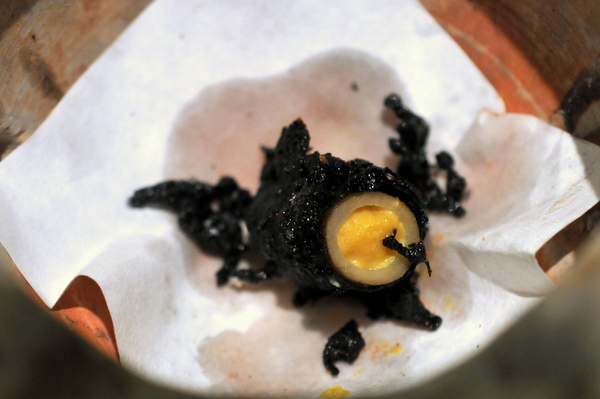 Kasu-jiru
Kasu-jiru - Oyster, Salmon, Root Vegetables
Next up was a traditional winter soup made with sake-lees. The soup has a hearty milky thickness with a sweet woodiness akin to a whiskey cask. The shellfish is certainly enjoyable, but it was pastoral heft of the root vegetables that worked best with the broth.
 Tako
Tako
Next up was a rare treat raw live octopus from Hokkaido. The ivory slivers have a slightly slimy crunch to them that required a fair amount of worrying to break down. To alleviate this, the sashimi came with a heated Himalayan salt block and a quick sear deftly softened the texture while simultaneously seasoning the octopus.
 Uni
Uni
Nobu said he doesn't normally serve uni to guests from California figuring its probably better local, but he said this was an exceptional urchin. Served simply in a bath of light brine, the roe was a quivering creamy mass of sweet saline perfection.
 Sushi Taro
Sushi Taro - Tokubetsu Junmai, Niigata prefecture
After dispensing with the Coedo, I decided to order a bottle of the house sake. Nobu found this sake during a visit to his hometown in Niigata and while it isn't the most refined sake; no fruit or vinous elements here just a viscous texture and a straightforward rice-y sweetness.
 Kabura Mushi
Kabura Mushi - Amadai, Turnip, Lily Bulb, Ginko
This was one of two steamed dishes of the night. One of the lighter dishes of the night, the base was made from grated turnip that radiates with a faint daikon-like funk and neither the fish nor any of the accompaniments do much to alleviate things. There was a thick glaze of some sort but even that was fairly mild.

Next up was one of my favorite part of the night. Just before serving the sashimi, Nobu slowly reveals box after box of pristine shellfish. As always I let Nobu pick what fishes to serve now and what he wants to serve as nigiri.
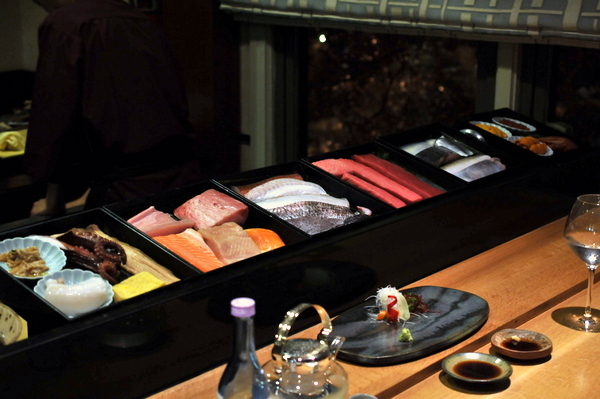 Tako
Tako - Octopus
First up was a more classically prepared octopus from Portugal. Though boiled, the sliver was still on the rare side with a pleasing dense snap to it. Not quite as impressive as the Hokkaido version but still one of the finest preparations that I've had.
 Buri
Buri - Adult Yellowtail
Next up was a piece of beautifully marbled mature yellowtail, fatty and lush, the Buri had the prototypical flavor of yellowtail writ large.
 Seared Buri
Seared Buri - Seared Adult Yellowtail
The seared version loses some of the subtlety and trades it for a buttery Toro-like richness.
 Shiro Sake
Shiro Sake - White Salmon
This was my first time having white salmon. Aside from the color the fish is quite similar to the more common version with perhaps a bit more fishy savor to it.
 Kurodai
Kurodai - Black Snapper
Black snapper tends to be one of the highlights of any sushi meal and this was no different. The paper thin sliver of pink flesh is flecked with bits of silver and despite having a firm lean snap there was a subtle hint of oiliness on the finish.
 Yagara
Yagara - Flute Fish
My second experience with the rare flute fish in as many weeks. Delicate and mild with a soft even texture, the Yagara felt a bit boring.
 Ishigaki Dai
Ishigaki Dai - Spotted Knifejaw (Parrot Snapper)
I think this might be my first time having Ishigaki Dai. Easily one of the firmest fishes I've ever eaten, almost like chewing a piece of raw tendon.
 Kama Toro
Kama Toro - Fatty Tuna
Nobu mentioned that just earlier in the day he'd purchased a tuna from New Jersey and as a result there was Kama-toro available. The generously marbled tuna almost looks more like a slice of Wagyu then it does fish. The biting into the delicately scored flesh releases a torrent of velvety fat and fish oil.
 Akami
Akami - Lean Tuna
This was night-and-day from the previous piece. Firm and even textured, the blood-red flesh conveys a sense of clean freshness.
 Suma
Suma
Nobu called this fish Suma, but didn't know the English translation. With flecks of silver skin and a sheen of oil coating the flesh, I was expecting a Mackerel-like intensity. While the fish had a dense oily texture the flavor was surprisingly delicate.
 Saba
Saba - Mackerel
When compared to the suma, the mackerel has a similar compact denseness but with a drier slightly dessicated feel. The Saba has a more traditional silver-skinned flavor with a cooler almost steely twang on the finish.
 Uni
Uni - Sea Urchin
Having already tasted the West Coast uni earlier, I opted to try the East Coast version during the sashimi courses. With a darker complexion and more compact size, the roe has a more viscous mouth feel than its Pacific cousin but a relatively mild flavor.
 Amaebi
Amaebi - Sweet Shrimp
This may well have been the largest sweet shrimp that I've ever eaten, in fact the piece pictured is only half of the shrimp. With spot prawn so readily available in California this is my first time having Amaebi from Canada, the texture is absolutely enchanting running the gamut from crunchy to creamy with a gentle saline sweetness throughout.
 Kobe Tenderloin
Kobe Tenderloin - Truffles, Uni
The sashimi dispensed with Nobu broke out the big guns with a decadent mixture of seared Kobe tenderloin topped with truffles and uni, that I dubbed a Japanese Rossini. The tenderloin doesn't have the over-the-top fattiness normally associated with Wagyu, instead the meat is suffused with a pure note of beefy richness. The truffles and uni are both relatively restrained, the former adding an overarching earthiness while the latter brings a touch of creamy salinity.
 Soba
Soba - Karasumi
The next course consisted of handmade soba courtesy of Masa. The soba comes with a traditional sauce though Nobu advised me to use it sparingly and let the a duet of mullet roe; a mound of golden loose eggs and a deep orange preserved version provide most of the flavor. The toasty nutty flavor of the soba works beautifully in concert with the salty fresh roe but really shines with the nutty super-umami flavor of the Karasumi; very reminiscent of a spaghetti alla bottarga.
 Mehikari
Mehikari - Green Eye
Prior to serving the soba, Nobu showed me a pair of small silvery deep-sea fishes he called Mehikari. Served tempura style the fish is tender with a balanced intrinsic savor but it was the airy wisp of bone that really stood out. A trio of stuffed Ginko nuts brings a sweet nutty contrast to balance the Mehikari's savor
 Sujiko
Sujiko - Salmon Roe
Salmon Roe comes in two varieties in Japanese cuisine, unlike the more popular Ikura, Sujiko is marinated in the egg sac and takes on a reddish hue and a slightly dessicated look. Considered more of a delicacy, the Sujiko tastes like a concentrated Ikura with a thicker, slightly tacky texture to it.
 Yagara
Yagara - Grilled Flute Fish, Liver
Time for Yagara round 2, this time the fish was seasoned with shoyu koji then grilled. The fish was solid but unexceptional dense and sweet with a nice smoky savor. The bit of liver was exceptional sweet and creamy it compared quite favorably to ankimo.
 Kirin-zan
Kirin-zan - Junmai Daiginjo, Niigata prefecture
I decided to order a more refined sake to close out the meal. Nobu recommended the Kirin-zan, a delicate floral sake that goes down clean with a light touch of melon-y sweetness
 Funa Zushi
Funa Zushi
Between
Q and now Sushi Taro I've been getting quite the sushi history lesson in recent weeks. According to Nobu, Funa Zushi is a Japanese adaptation of the original sushi first developed in Thailand. Making Funa Zushi involves aging fish in salt for a year before placing in fermented cooked rice. The resulting product can keep for up to four years. After being removed from the rice, the fish is packed with a yellowish carp roe. The flavor was like a cross between mackerel and a really strong cheese with more than a whiff of ammonia to boot. Texturally the fish is dense and chewy, not too surprising since most of the water has long been extracted. While I appreciated the opportunity to try the Funa Zushi, I'm immensely thankful that sushi has evolved over the past millennium as this was easily the most challenging thing I've eaten all year. After eating this I asked Nobu how often he serves this, apparently I was the second guest to try it, lucky me.
 Chawan Mushi
Chawan Mushi - Daikon, Scampi, Shaved Foie Gras
The second steamed course was one of the highlights of the evening and consisted of a hollowed out ring of succulent daikon stuffed with fresh scampi and topped with shaved foie gras. The scampi is cooked perfectly with a nuanced shellfish brine that pairs exquisitely with the fatty liver.
 Hamaguri
Hamaguri - Topneck Clam
With the end of the kaiseki courses it was time to go back to Nobu's boxes of joy for some nigiri. I started with the Top Neck clam, a dense slightly chewy clam with a pronounced earthy heft and dark rich sweetness from the sauce.
 Kawahagi
Kawahagi - Trigger Fish
Another relative rarity, Kawahagi is often served as a substitute for fugu during the summer. A mild supple fish, Nobu topped his with some ankimo to give the piece a lovely countervailing richness.
 Amadai
Amadai - Tilefish
The Tilefish was one of my favorites with a dense jellied texture there was a kobujime like butteriness that I wasn't expecting.
 Mejina
Mejina - Large Scale Blackfish
I've only had Mejina a handful of times, lean and mild the fish has a unique sinewy toughness.
 Kamasu
Kamasu - Barracuda
A must order for me, grilled barracuda is always a treat. In winter the fish becomes heavy with fat which lends itself well to searing or grilling. The resulting fish is super-tender with a sharp woody scent intermingled with charred fish oil.
 Inada
Inada - Baby Yellowtail
Having served the buri as sashimi, Nobu opted to go nigiri-style with the Inada. The baby yellowtail is much lighter in flavor but still utterly tender albeit in a different fashion than the buri.
 Ikura
Ikura - Salmon Roe
Everything from the tactile feel of the orbs bursting to the gentle sweet saline marked this as a classic quintessential Ikura.
 Ebi
Ebi - Madagascar Shrimp
I'm not normally a fan of Ebi, finding the boiled shrimp dull and rubbery. Luckily Nobu agrees with me and stops cooking his while its still raw in the center. The result is a lithe lively shrimp still conveying a delicate essence of sweet brine.
 Kohada
Kohada - Gizzard Shad
I've seen chefs do some funny things with fishes but this was the first time I've had one braided before. As always the dry compact fish is saturated with oily goodness
 Tamago
Tamago - Egg
A fairly typical tamago the sweet eggy funk paired nicely with the warm rice.
 Echigo Stout
Echigo Stout
Given how hard Nobu had worked up until now I thought it only fair to buy him a beer. He decided on the Echigo Stout, done in an American Imperial style, the beer has an aroma of chocolate and coffee with a hint of smoke. Dense and sweet to start there are some roast-y bitter notes on the finish.
 Caramel Mochi Ice
Caramel Mochi Ice - mochi mixed milk ice cream, topped w/ fresh caramel syrup
I know it's a bit simple but after 38 savories, I was craving something utterly sweet and decadent and this fit the bill perfectly.
 Anmitsu
Anmitsu - green tea ice cream served over an assortment of mochi, red bean, and flavored jelly cubes, topped w/ dark syrup
Nobu decided to send out his favorite dessert for me to try. Much more restrained than the caramel mochi, Anmitsu is a traditional Japanese dessert of agar gelly with azuki bean paste. Nobu's version is a bit more elegant pairing the duet with a bitter and refreshing green tea ice cream.

Nobu's cooking deftly highlights his immense talent and unbridled creativity while respecting the bounds of Japanese culinary tradition. My
previous visit was one of the my top meals of 2012 and this experience was every bit as impressive. For any fans of Japanese Cuisine visiting the DC area, dinner at Sushi Taro's Omakase Counter is an absolute must.
 Read more.
Read more.




 Yamakase | Steamed Awabi - Yuba, Truffle Butter
Yamakase | Steamed Awabi - Yuba, Truffle Butter
